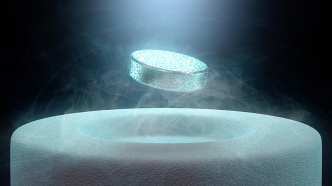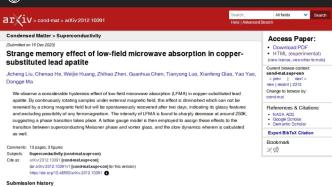

"Our work pointed out the reason why LK-99 was misidentified as a superconductor." Luo Jianlin, a researcher at the Institute of Physics of the Chinese Academy of Sciences and a doctoral supervisor, told The Paper.
A newly published preprint paper from the Chinese Academy of Sciences research team on the arXiv website may put an end to "LK-99 is a room temperature superconductor".
Recently, because the LK-99 material was claimed by a Korean research team to be capable of superconducting at room temperature, preprinted papers on LK-99 "swarmed" into the arXiv website. But it may come to an end soon: A newly published preprinted paper on the arXiv website not only shows that LK-99's room temperature superconductivity is an illusion, but also finds the cause of this illusion-cuprous sulfide impurities.
In addition, scientific research teams from Peking University Quantum Materials Science Center, Princeton University and other institutions also submitted preprinted papers saying that although they observed that none of the "fired" LK-99 samples showed superconductivity, they were more like magnets. , rather than a room-temperature superconductor.
On August 9, Luo Jianlin, one of the corresponding authors of the aforementioned paper, a researcher at the Institute of Physics of the Chinese Academy of Sciences, and a doctoral supervisor, told The Paper, "Our work points out the reason for misidentifying LK-99 as a superconductor. ""The experimental results show that (LK-99 can superconduct at normal pressure and room temperature) is an illusion, which comes from cuprous sulfide." "LK-99 is not superconducting! There is no zero resistance phenomenon."
The paper was submitted to the arXiv website at 15:59 on August 8 and has been released to the public.
The team of the Institute of Physics, Chinese Academy of Sciences: LK-99 looks superconducting, but it is not actually, cuprous sulfide leads to false appearance
Cuprous sulfide is one of the products of the process of "firing" LK-99. LK-99 is a copper-doped lead apatite material with a composition of Pb10-xCux(PO4)6O (0.9<x<1.1).
In the experiment, Wu Wei and other researchers "fired" two kinds of LK-99 with different cuprous sulfide contents, measured their resistance, diamagnetism and other parameters, and compared them with the corresponding parameters of pure cuprous sulfide. Among them, the "strength ratio" parameter reflecting the cuprous sulfide content of sample 1 (S1) is about 5%, and this parameter of sample 2 (S2) is about 70%.
The experimental results show that the resistivity of sample S1 jumps at 370K (96.85 degrees Celsius), accompanied by thermal hysteresis; the resistivity of sample S2 drops sharply at 370K (96.85 degrees Celsius), and the resistivity drops below 100K (minus 173.15 degrees Celsius). increases with decreasing temperature, exhibiting semiconductor-like characteristics.
Zero resistance and complete diamagnetism at the critical temperature are two important characteristics of superconductors.
Luo Jianlin told Pengpai Technology that cuprous sulfide has a structural phase transition from "hexagonal phase" to "monoclinic phase" near 400K (126.85 degrees Celsius). Near the phase transition point, its resistance drops by more than 3 orders of magnitude. This looks like a "superconducting" phase transition, but it's not. The current experimental evidence shows that it is impossible to achieve superconductivity by increasing or decreasing the content of cuprous sulfide in the sample or other methods.
The aforementioned paper reads, “We believe that the so-called superconducting behavior in LK-99 is likely due to the first-order structural phase transition of cuprous sulfide at around 385K (111.85 degrees Celsius), from the β phase at high temperature to the β phase at low temperature. γ phase, resulting in a decrease in resistivity."
According to previous reports from The Paper, on the morning of July 22, the relevant research team of Korea Quantum Energy Research Center submitted two similar papers on the preprint website arXiv, claiming that a copper-doped lead phosphor named LK-99 Stone materials have "room temperature + normal pressure" superconducting ability. Subsequently, a number of international research teams began to repeat experiments, attempting to synthesize LK-99 in order to reproduce the experimental results of the Korean team. The news also had an impact on global stock markets.
At 16:13 on July 31, the team of Professor Liu Zhiqi from the School of Materials Science and Engineering of Beihang University submitted a paper on the preprint website arXiv. According to the paper, the room temperature resistance of the synthesized LK-99 sample is not zero, and no magnetic levitation phenomenon has been observed; the material is similar to a semiconductor, not a superconductor.
At 14:59 on August 2, Sun Yue, a professor and doctoral supervisor at the School of Physics of Southeast University, submitted a paper on the preprint website arXiv, saying that at a temperature above 100K (minus 173.15 degrees Celsius), his LK-99 sample measured zero resistance. But not diamagnetic. Sun Yue said in the video that a total of 6 samples were measured, but only zero resistance was observed in 1 sample, and most of the other samples produced semiconductor behavior. "Our findings suggest that Pb10-xCux(PO4)6O may be a candidate material in the search for high-temperature superconductors," the paper states.
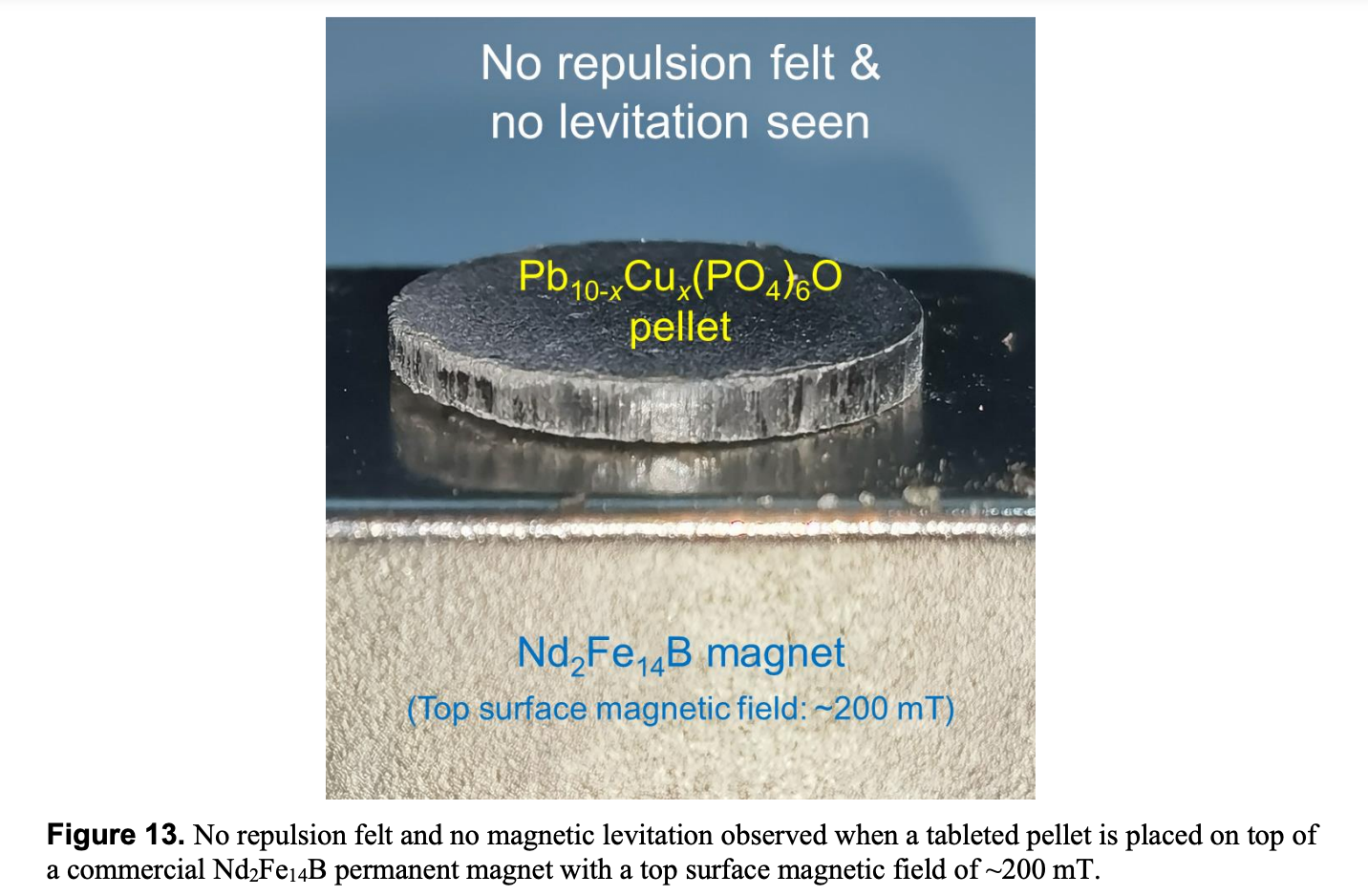
The research team of Beihang University submitted a preprint paper stating that no magnetic levitation was observed in repeated experiments.
Peking University Quantum Materials Science Center team: observed LK-99 sample "semi-suspension", but not superconducting
At 13:34 on August 6 , researchers from Peking University's Center for Quantum Materials Science (ICQM) submitted an article on the preprint website arXiv entitled "Ferromagnetic half levitation of LK-99-like synthetic samples" (Ferromagnetic half levitation of LK-99-like synthetic samples).
Magnetic semilevitation under ambient conditions is considered a "spectacular and readily accessible" phenomenon, and thus has been the focus of LK-99 material verification experimental attempts, the paper says. Although the research team of Peking University successfully observed the "magnetic semi-levitation" phenomenon in some flake-like small fragment samples, it was measured that there was no Meissner effect or zero resistance in the samples, so they did not have superconductivity. Experimental results show that its samples generally contain weak but definite soft ferromagnetic components.
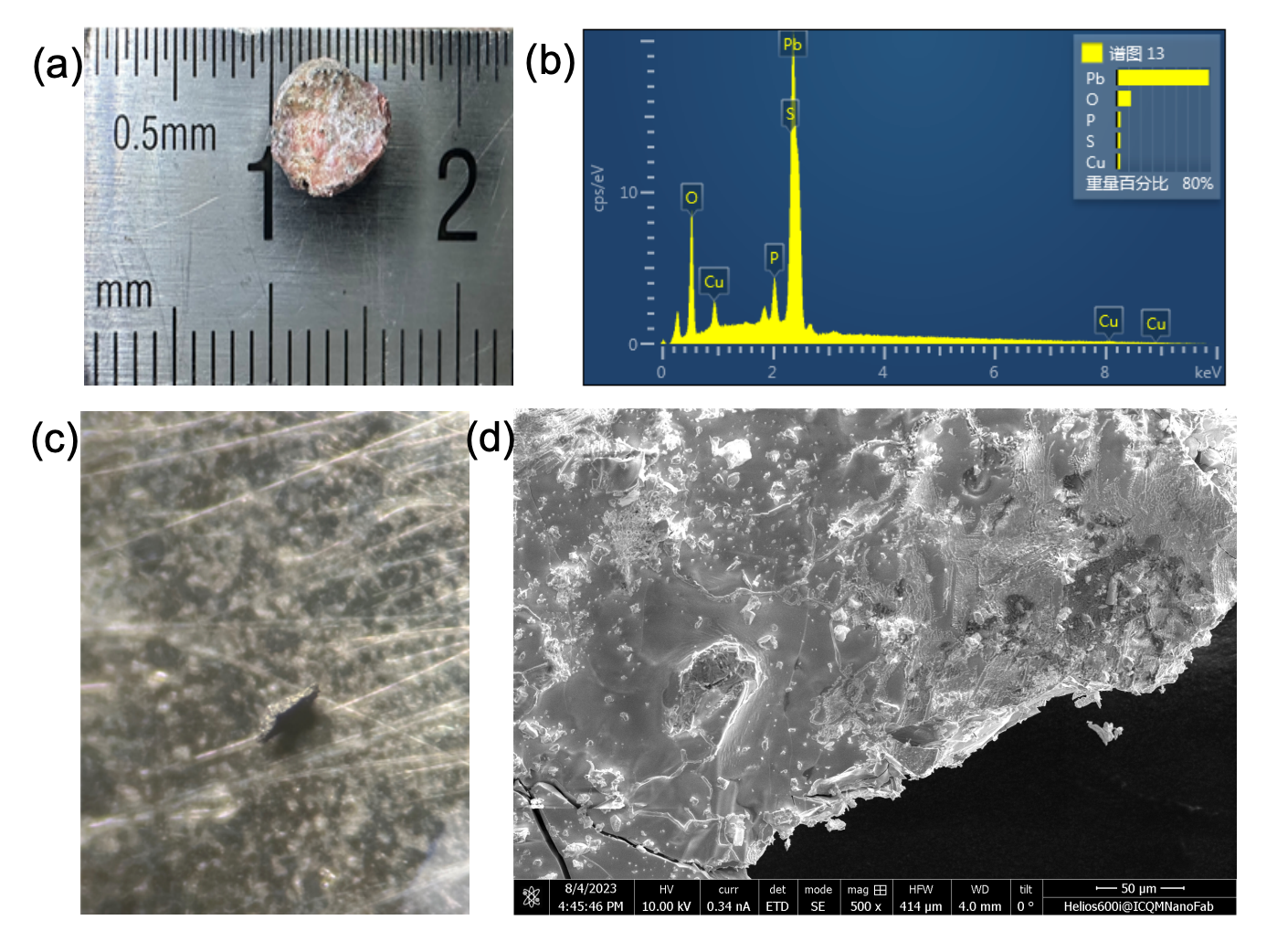
The LK-99 sample synthesized by the research team of Peking University Center for Quantum Materials Science (ICQM).
The research team believes that soft ferromagnetism is sufficient to explain the semi-levitation of their samples in a strong vertical magnetic field. According to the paper, "recent calculations reveal the existence of a flat-band electronic structure in Pb10-xCux(PO4)6O, which may lead to spontaneous ferromagnetism and deserves further investigation."
Jia Shuang, an associate professor at Peking University, a researcher at the Center for Quantum Materials Science at Peking University, and a doctoral supervisor, and Li Yuan, an associate professor at Peking University, are the corresponding authors of the above paper.
Huazhong University of Science and Technology team: The sample can be "semi-suspended" at a large angle, but the resistance has not been measured
At 3:13 a.m. on August 3, the team of Professor Chang Haixin from the School of Materials Science and Engineering of Huazhong University of Science and Technology, which caused a sensation by publishing the video of the LK-99 verification experiment on the Bilibili website, submitted a paper on the preprint website arXiv and made it public. the progress of their experiments. The title of the paper is "Successful growth and room temperature ambient-pressure magnetic levitation of LK-99" (Successful growth and room temperature ambient-pressure magnetic levitation of LK-99).
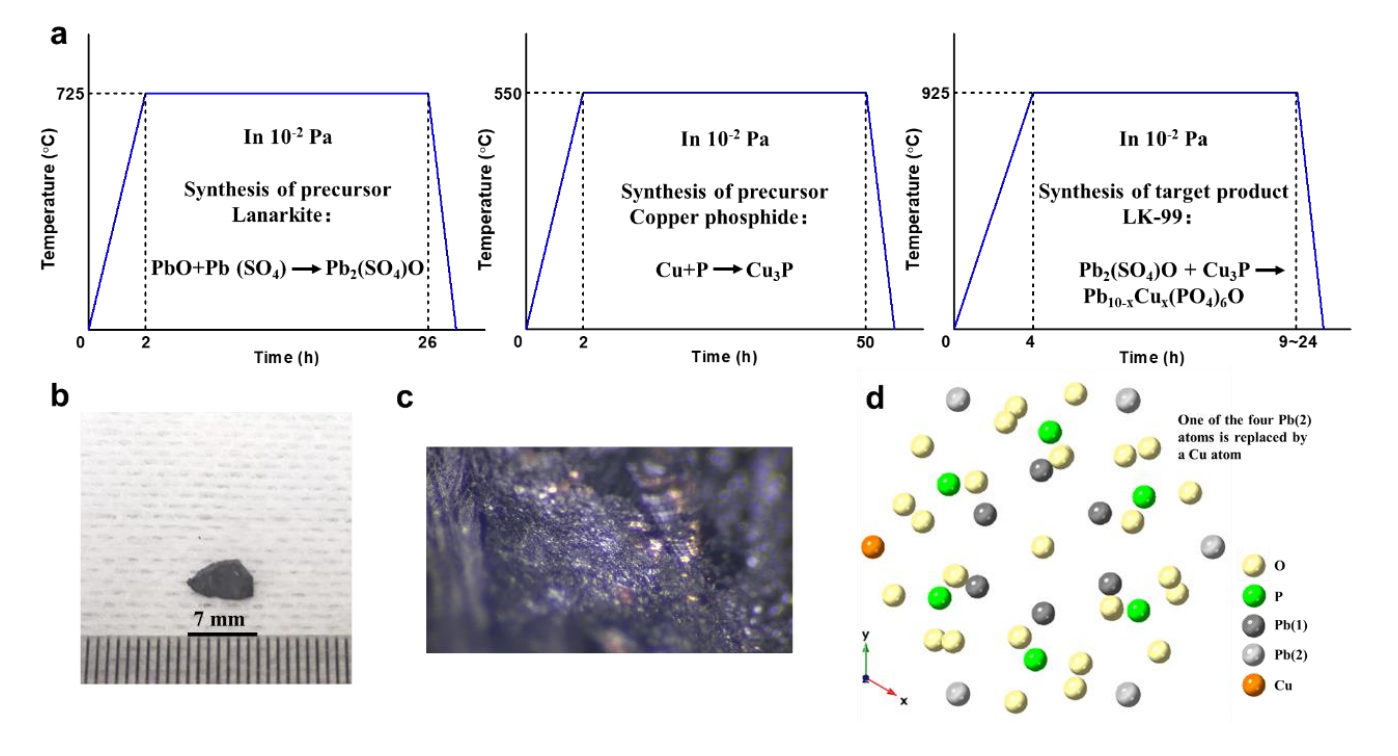
The experimental steps and final samples of LK-99 synthesized by the team of Professor Chang Haixin from the School of Materials Science and Engineering, Huazhong University of Science and Technology.
According to the paper, they successfully synthesized the LK-99 material, which can be "semi-suspended" at a large angle at room temperature and ambient pressure. "Our results demonstrate the importance of crystallinity and proper copper doping, suggesting a fundamental underlying superconducting mechanism for copper-oxygen-induced band changes in this phosphate oxide. We look forward to more consistent tests, such as room temperature Electrical tests underway will show the great potential of this phosphate oxide."
On August 1, Huazhong University of Science and Technology released a video about the repeated experiment of LK-99 material on the domestic website Bilibili (Station B), which became popular on social media at home and abroad. Related videos are listed as supplementary material to the aforementioned paper.
The introduction of the related video reads, "Postdoctor Wu Hao and doctoral student Yang Li of the School of Materials Science and Technology, Huazhong University of Science and Technology, under the guidance of Professor Chang Haixin, successfully verified and synthesized the LK-99 crystal that can be magnetically levitated for the first time. The magnetic levitation angle of the sample obtained by Lee et al. is larger, and it is expected to realize the real non-contact superconducting magnetic levitation.”
The publisher of the related video stated that the resistance of the related samples has not been measured. Because the measurement of resistance requires micro-nano processing, which destroys the sample. "At present, there is only a very small sample, and I dare not move it, I really dare not move it." The third batch of samples is being "fired" urgently.
The joint team of Princeton University and other institutions in the United States: LK-99 sample is transparent and excludes superconductivity
On August 9, a preprinted paper by Princeton University in the United States did not go viral, which attracted people's attention. This paper confirms the experimental results and conclusions of the research team of the Quantum Materials Science Center of Peking University.
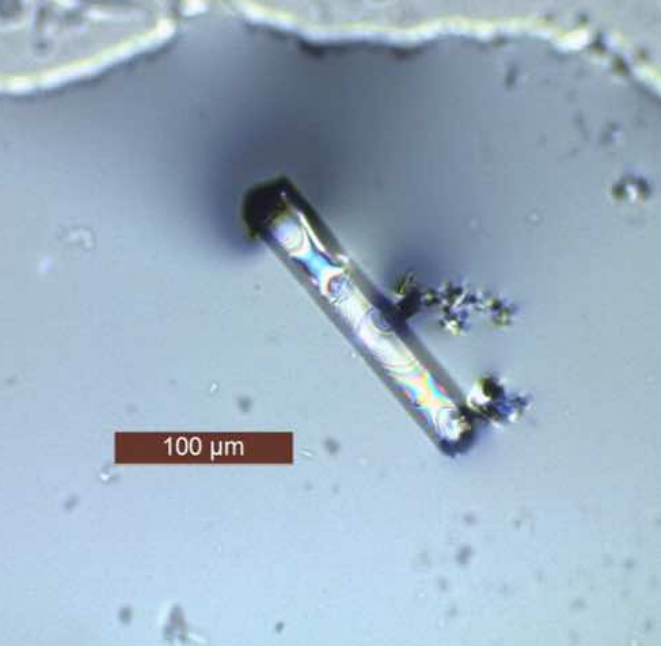
Transparent LK-99 sample.
Although the aforementioned paper by Princeton University in the United States has been submitted, it has not yet been officially published on the preprint website. The author has uploaded it to the online disk and shared it on the social media website on the 9th .
The research related to this paper was jointly completed by researchers from the Department of Physics and Chemistry of Princeton University , the Department of Chemistry and Biochemistry of the University of Oregon , and the Max Planck Institute for Chemical Physics of Solids in Germany .
According to the paper, in a series of recent reports, doped apatite lead (LK-99) was considered as a candidate room temperature and pressure superconductor. However, these claims have been largely unsubstantiated, both from an experimental and theoretical perspective. To this end, the research team synthesized a sample of LK-99, but the analysis results showed that the sample did not exhibit high-temperature superconductivity .

A preprinted paper jointly completed by researchers from the Department of Physics and Chemistry of Princeton University, the Department of Chemistry and Biochemistry of the University of Oregon, and the Max Planck Institute for Chemical Physics of Solids in Germany stated that the LK-99 sample is more It may be a magnet, not an ambient temperature and pressure superconductor.
The researchers calculated that the hexagonal channels of the material may contain OH- anions instead of divalent oxyanions; and the substitution of copper is very thermodynamically unfavorable . "The phonon spectrum of the equilibrium structure shows many unstable phonon modes." "Despite initial attempts to model LK-99 in this way, it is doubtful whether copper enters the structure in meaningful concentrations .” “Such bands are less likely to support strong superfluidity, and are instead prone to ferromagnetism (or out-of-plane antiferromagnetism) at low temperatures.” “In conclusion, Pb9Cu(PO4)6(OH)2 is more likely to be a magnet , rather than normal temperature and pressure superconductors ."
